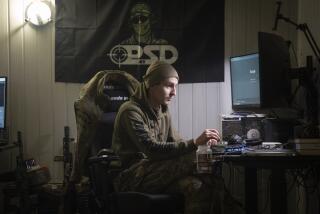The Need for High-Tech, Networked Cyberwar
- Share via
MONTEREY, CALIF. — In Kosovo, the North Atlantic Treaty Organization doggedly upheld a strategy limited almost entirely to aerial bombardment, slowly winning a problematic “negotiated victory,” at great cost to Kosovar and Serbian civilians.
Alliance leaders took the ground-invasion option off the table at the start, because of a mistaken belief that only a large field army, built up over months and engaging in sustained hard combat, could achieve victory. A close look at the last week of fighting, though, yields some important insights into how NATO’s objectives could have been more quickly and less bloodily achieved, and how future interventions can be undertaken more effectively.
Credit for success in Kosovo should go to the emergence of a new, information-age way of waging a ground campaign and integrating it, via advanced communications and organizational forms, with air and other assets. We call this “cyberwar,” a term we coined in 1992. Its glimmering can be seen in Kosovo and lies behind the success of the bombing campaign. It was the small bands of widely distributed Kosovo Liberation Army fighters and, to a lesser extent, allied special forces who provoked the Serbs to maneuver and fire, which instantly made them vulnerable to being attacked from the air. The results of this low-level, tiny ground campaign were startlingly successful and carry many lessons for the future.
An emergent mode of conflict, cyberwar is fundamentally a creature of the information revolution, not only of its technologies, but also the organizational and strategic innovations it fosters. Cyberwar means gaining an “information edge” so significant that a small force can defeat a large one. Specifically, cyberwar means operating in small, dispersed units, so well internetted that they can coordinate, coalesce and then dissever in repeated swarming attacks. Cyberwar thus requires a ground presence but without relying on conventional ground forces. It may require what we call a “BattleSwarm Doctrine” to supersede the reigning AirLand Battle Doctrine.
How does cyberwar unfold? Initially, light ground units infiltrate and take up dispersed positions. As areas are cleared, helicopter insertions are made more frequently and safely. The units may then act as scouts and guides, calling in accurate air, artillery and missile fire on multiple targets. At times and places of their choosing, the units may also engage in direct combat.
Advanced information-gathering tools--including orbital and aerial assets, night-vision equipment and unmanned sensors deployed along the lines of movement--let our units know where enemy units are, when they are moving and in what numbers. The ensuing cascade of information improves the precision of air power and helps our units determine where and when to move next. Places with rough terrain, like Kosovo, so daunting to plans for a conventional invasion, actually turned to NATO’s advantage, as the Serb efforts at maneuvering their tanks and artillery were forced onto narrow, constrained avenues of movement that made them easy pickings for NATO air power.
It would take serious study to assess just what size and shape ground force is needed under a cyberwar doctrine and how long it would take to win in a specific case. Our preliminary view is that a cyberwar campaign might require only one-tenth the number of an adversary’s forces, presuming the enemy adheres to conventional forms of organization and doctrine. Winning should take only a fraction of the time a massed conventional invasion would: weeks instead of months.
Enough cyberwar, in the form of infiltration by NATO-related special forces and KLA units, unfolded in Kosovo to reap considerable credit for the success of the air campaign and to suggest that a more deliberate effort should be made to evolve successfully in this direction.
What is our basis for this assertion? Some U.S. military forces have been experimenting with and preparing for years for cyberwar-like operations, often with stunning results. The Army’s “Force XXI” and the Marines’ expeditionary units have each practiced swarming tactics in small units, as have U.S. special forces. Some NATO members also have emerging cyberwar capabilities: French and British units have prepared for this new way of war, and British and Canadian special forces operated aggressively on the ground in Kosovo. Thus, well-trained troops are available in sufficient numbers to wage cyberwar. The challenge is less one of finding suitable units than of assuring they are properly internetted for communication and coordination, with each other and with surveillance, fire and other logistical support units.
What are some risks of waging cyberwar? Enemy forces might figure out how to disrupt the communications of cyberwar units, exposing some to defeat. But communications can be hardened and made redundant, mitigating this risk. Second, a cyberwar, far more than a massed ground invasion, may place widely distributed troops at risk behind enemy lines. However, a cyberwar approach could eliminate the need to assault heavily mined, well-defended enemy frontier positions, offsetting this risk. Finally, if an enemy retreats to wage a guerrilla war, still a worry in Kosovo, they will often have to do so where the local populace roundly opposes them and is increasingly well-armed and well-informed.
In sum, even with the risks, cyberwar may offer a new way to win decisively, at low cost in blood and treasure, without relying on a bombing campaign that causes troubling collateral damage, especially among civilians. Seen in this light, the fighting in Kosovo may be a stepping stone toward the development of a much-needed cyberwar strategy. We should never again wage war in a fashion that suits our political constraints, but which subjects those we would protect to the worst sort of unfettered barbarism.*
More to Read
Sign up for Essential California
The most important California stories and recommendations in your inbox every morning.
You may occasionally receive promotional content from the Los Angeles Times.













